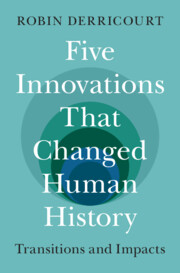Refine search
Actions for selected content:
96 results
Chapter 9 - Fidelity of Concepts and Register
-
- Book:
- Translating Virgil
- Published online:
- 15 May 2025
- Print publication:
- 05 June 2025, pp 673-768
-
- Chapter
- Export citation
Chapter 0 - First Attempts and First Principles
-
- Book:
- Translating Virgil
- Published online:
- 15 May 2025
- Print publication:
- 05 June 2025, pp 1-55
-
- Chapter
- Export citation
5 - Monocultures and the Rise of Diversity in Agroecology
-
- Book:
- The Dialectical Agroecologist
- Published online:
- 31 October 2024
- Print publication:
- 14 November 2024, pp 99-116
-
- Chapter
- Export citation
Millets, dogs, pigs and permanent settlement: productivity transitions in Neolithic northern China
-
- Journal:
- Evolutionary Human Sciences / Volume 6 / 2024
- Published online by Cambridge University Press:
- 11 November 2024, e44
-
- Article
-
- You have access
- Open access
- HTML
- Export citation

Five Innovations That Changed Human History
- Transitions and Impacts
-
- Published online:
- 01 November 2024
- Print publication:
- 21 November 2024
Introduction
-
- Book:
- Feral Empire
- Published online:
- 30 May 2024
- Print publication:
- 06 June 2024, pp 1-13
-
- Chapter
- Export citation
3 - The Paradox of Abundance and Illusion of Control
-
- Book:
- Feral Empire
- Published online:
- 30 May 2024
- Print publication:
- 06 June 2024, pp 74-106
-
- Chapter
- Export citation
5 - Ferality and Breed in “New World” Horses
-
- Book:
- Feral Empire
- Published online:
- 30 May 2024
- Print publication:
- 06 June 2024, pp 143-176
-
- Chapter
- Export citation
Radiocarbon Dates from the Archaeological Site of Sakas, Bihar, India
-
- Journal:
- Radiocarbon / Volume 66 / Issue 2 / April 2024
- Published online by Cambridge University Press:
- 29 April 2024, pp. 267-279
- Print publication:
- April 2024
-
- Article
-
- You have access
- Open access
- HTML
- Export citation
A geometric morphometric approach to distinguish ferret from polecat and its application to an archaeological specimen from Mechelen (Belgium)
- Part of
-
- Article
-
- You have access
- Open access
- HTML
- Export citation
Exploring the nutritional potentials of wild Vigna legume species for neo-domestication prospects
-
- Journal:
- Plant Genetic Resources / Volume 22 / Issue 2 / April 2024
- Published online by Cambridge University Press:
- 14 February 2024, pp. 59-68
-
- Article
-
- You have access
- Open access
- HTML
- Export citation
Participatory tree selection and fruit morphological characterization of Phoebe cooperiana (U.N Kanjilal ex A. Das) in the Eastern Himalayas of India
-
- Journal:
- Plant Genetic Resources / Volume 21 / Issue 6 / December 2023
- Published online by Cambridge University Press:
- 01 December 2023, pp. 481-489
-
- Article
- Export citation
The genetic diversity and population structure of weedy rice in northeast Thailand accessed by SSR markers
-
- Journal:
- Weed Science / Volume 71 / Issue 6 / November 2023
- Published online by Cambridge University Press:
- 23 October 2023, pp. 594-605
-
- Article
- Export citation
Turning Over a New Leaf: Experimental Investigations into the Role of Developmental Plasticity in the Domestication of Goosefoot (Chenopodium berlandieri) in Eastern North America
-
- Journal:
- American Antiquity / Volume 88 / Issue 4 / October 2023
- Published online by Cambridge University Press:
- 18 September 2023, pp. 554-569
- Print publication:
- October 2023
-
- Article
-
- You have access
- Open access
- HTML
- Export citation
Cultivation potential of Taraxacum campylodes G.E.Haglund wild populations: morphological and biochemical variation
-
- Journal:
- Plant Genetic Resources / Volume 21 / Issue 1 / February 2023
- Published online by Cambridge University Press:
- 17 July 2023, pp. 71-80
-
- Article
- Export citation
28 - Moving Muskoxen as an Arctic Resource in the Twentieth Century
-
-
- Book:
- The Cambridge History of the Polar Regions
- Published online:
- 24 March 2023
- Print publication:
- 11 May 2023, pp 702-725
-
- Chapter
- Export citation
Some Comments on the Review of Nimon and Broom on the Welfare of Farmed Mink
-
- Journal:
- Animal Welfare / Volume 10 / Issue 3 / August 2001
- Published online by Cambridge University Press:
- 11 January 2023, pp. 315-323
-
- Article
- Export citation
The Welfare of Farmed Mink (Mustela Vison) in Relation to Behavioural Selection: A Review
-
- Journal:
- Animal Welfare / Volume 10 / Issue 1 / February 2001
- Published online by Cambridge University Press:
- 11 January 2023, pp. 41-52
-
- Article
- Export citation
How has the risk of predation shaped the behavioural responses of sheep to fear and distress?
-
- Journal:
- Animal Welfare / Volume 13 / Issue 3 / August 2004
- Published online by Cambridge University Press:
- 11 January 2023, pp. 269-281
-
- Article
- Export citation
5 - The Transition to Agriculture
- from Part II - Sedentism and Agriculture
-
- Book:
- Economic Prehistory
- Published online:
- 10 February 2023
- Print publication:
- 05 January 2023, pp 157-214
-
- Chapter
- Export citation
